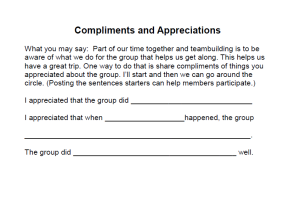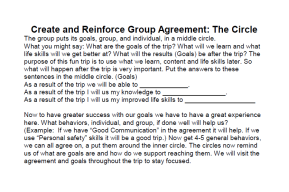 |
April 2016
|
April 2016 // Volume 54 // Number 2 // Ideas at Work // v54-2iw4
Supercharging Chaperones: A Meeting Toolkit for Maximizing Learning for Youth and Chaperones
Abstract
Trip and conference chaperones are a wonderful resource in youth development programs. These well-intended volunteers, many parents of youth participating in the event, want the best experience for the youth but are not necessarily trained in positive youth development. A consequence of this circumstance is that not all chaperones provide the best opportunities for youth learning. Providing a card-based resource kit that allows for flexibility supports chaperones in running event meetings that are fun and engaging and that improve learning of content and development of life skills.
The Importance of Learning Content and Life Skills
Trips and conferences provide opportunities for youth to increase social emotional skills, or life skills, whereas in school, such opportunities are lacking (Astroth, 1996). However, because knowledge gain is the focus of a conference, the intentional development of life skills may not occur. With life skills as a goal of many youth organizations, conferences that include life skills–focused meetings better reach organizational goals. Child Trends, a nonpartisan research center designed to identify best practices founded in research, specified that quality youth programs "promote a sense of physical and emotional safety, enable youth to build positive relationships, allow youth a role in decisions, and support development of social skills" (Moore & Hamilton, 2010, Overview section). Furthermore, a metastudy by Collaborative for Academic Social and Emotional Learning (CASEL) indicated that by including life skills in programs, some of the many benefits to youth are improved interactions, decreased negative behaviors, and improved academic scores (Durlak, Weissberg, & Pachan, 2010).
Current State of Chaperoning Support
Many resources related to risk management and general responsibilities of chaperones exist; however, support for running a highly engaging meeting in which learning and life skills are improved is lacking. The resources that do exist ill-prepare chaperones, many of whom are untrained parents (Griffin & Symington, 1997; Parsons & Breise, 2000; Wood, 2010). An observation of 289 parent chaperones showed that many chaperones assume roles counter to the expectations of the trip planners (Wood, 2010). Also, chaperones engage in less discussion than trained staff members do (Burtnyk & Combs, 2005). Although there are issues, there are solutions. Some of these solutions involve providing more training to chaperones, including training on how to support youth learning (Fox, Hebert, Tassin, & Hebert, 2008; Parsons & Breise, 2000; Wood, 2010), how to develop life skills through social adult-youth interactions (Fogarty, Terry, Pracht, & Jordan, 2009; Paisley & Ferrari, 2005), and how to increase youth social interactions (Bechtel, 2002; Falk & Dierking, 2000). Another suggestion for improving youth outcomes from a conference is to include structure and tools for encouraging discussion during and after the trip (Kisiel, 2006; Parsons & Muhs, 1995). The common finding is that when more training and tools are provided to chaperones, a greater positive impact on youth learning results.
Supercharging Learning Through the Use of a Meeting Toolkit
This article discusses a card-based curriculum that supports chaperones in running event meetings. The primary purpose of the curriculum is to provide a structure for meetings that improve the knowledge and life skills learned by youth at conferences. The secondary purpose is to provide a tool for volunteers working with such youth.
The design of the chaperoning curriculum, or toolkit, was based on the 4-H targeted life skills model and the CASEL after-school programs (ASPs) research. The 4-H targeted model involves selecting a few life skills that support and match the content of an event (Hendricks, 1998). The CASEL metastudy resulted in the following finding:
The presence of four recommended practices associated with previously effective skill training moderated several program outcomes. These are SAFE: sequenced, active, focused, and explicit. One important implication of current findings is that ASPs should contain components to foster the personal and social skills of youth because youth can benefit in multiple ways if these components are offered. (Durlak et al., 2010, Abstract)
The toolkit is intentional in its targeted approach and follows the SAFE acronym to maximize the positive results to youth. Providing strong support to volunteers helps them become more motivated and successful (Fox, Hebert, Martin, & Bairnsfather, 2009). The toolkit can be used as a template for developing unique sets of cards for specific trips.
Objectives
Youth Goals
- To increase trip/conference knowledge gained
- To increase life skills development
- To increase the application of learning after the event
Chaperone Goals
- To improve volunteer adults' skills in working with youth at the event
- To provide a toolkit that can be used for other youth meetings after the trip
Features of the Cards and the Meeting Agenda
The curriculum provides a basic outline for engaging youth by using experiential education tools and techniques for pre-event activities, event meetings, and postevent activities. Three targeted life skills areas that relate to trips are addressed: personal safety, accepting differences, and marketable/job skills. Moreover, certain toolkit cards include blank areas for inserting other appropriate life skills to target. Activities have been selected that are simple, require few to no props and little to no space, and are engaging, as meetings may occur late at night. There are multiple cards to choose from, allowing chaperones to select cards on topics they feel comfortable addressing. Leading questions are provided, but the chaperone has flexibility to divert to and discuss needed topics as appropriate. (Example cards are shown in Figure 1.) The meeting agenda has six sections, each with associated activities:
- Get-to-know-you activities are designed to build positive relationships among participants and help everyone learn names.
- Compliments and appreciations support a positive culture.
- Learning and support activities foster success by creating activities that support youth's discussing their learning.
- Create/reinforce group agreement activities help promote youth's engaging in successful behaviors.
- Business items address conference logistics.
- Closing/reflection activities engage youth in discussing knowledge and life skills learning and how they will use what they have learned in the future.
Figure 1.
Example Cards




Guidance for Using a Meeting Toolkit
Providing the chaperoning toolkit cards, or an original set of activity cards, equips volunteers who are at various skill levels with helpful, practical tools. The following guidance can lead to success for volunteers and youth using such tools:
- The goals for life skills development and knowledge to be learned on a trip, the meetings' roles in these goals, and the objective of using learning after the trip must be clearly known to volunteers and youth. Ideally, the youth cocreate the goals with staff and the volunteer.
- The volunteer plans the meetings and selects activity cards before the trip. However, it is appropriate for a volunteer to modify a plan once on the trip, if needed.
- Volunteers can model improvement by sharing their life skills and knowledge learning.
- Rephrasing questions can help some youth process questions more effectively.
- Consistently following the format of "what, so what, and now what" helps youth develop processing fluency.
- The idea is to have fun.
- The use of learning after an event is greatly improved if youth create goals before the event regarding how they will use their learning for themselves, their group, their community, or their world.
- A follow-up event or phone call supports the youth in applying their learning and offers an opportunity to evaluate the impacts of the event.
References
Astroth, K. (1996). Leadership in nonformal youth groups: Does style affect youth outcomes? Journal of Extension [online], 34(6). Available at: http://www.joe.org/joe/1996december/rb2.html
Bechtel, R. B. (2002). Handbook of environmental psychology. New York, NY: John Wiley & Sons, Inc.
Burtnyk, K. M., & Combs, D. J. (2005). Parent chaperones as field trip facilitators: A case study. Visitor Studies Today, 8(1), 13–20.
Durlak, J. A., Weissberg, R. P., & Pachan, M. (2010). A meta-analysis of after-school programs that seek to promote personal and social skills in children and adolescents. American Journal of Community Psychology, 45, 294–309.
Falk, J. H., & Dierking, L. D. (2000). Learning from museums: Visitor experiences and the making of meaning. Lanham, MD: Altamira Press.
Fogarty, K., Terry, B., Pracht, D., & Jordan, J. (2009). Organizational supports and youth life skill development: Adult volunteers as mentors, managers and "mediators." Journal of Youth Development, 4(4). Article 090404FA002.
Fox, J., Hebert, L., Martin, K., & Bairnsfather, D. (2009). An examination of the benefits, preferred training delivery modes, and preferred topics of 4-H youth development volunteers. Journal of Extension [online], 47(1) Article 1RIB2. Available at: http://www.joe.org/joe/2009february/rb2.php
Fox, J. E., Hebert, L., Tassin, M., & Hebert, C. (2008). Using risk management tools and training to protect youth and adults in overnight settings. Journal of Extension [online], 46(6). Available at: http://www.joe.org/joe/2008december/rb6p.shtml
Griffin, J., & Symington, D. (1997). Moving from task‐oriented to learning‐oriented strategies on school excursions to museums. Science Education, 81(6), 763–779.
Hendricks, P. A. (1998). Targeting life skills model. Ames, IA: Iowa State University Extension.
Kisiel, J. (2006). Making field trips work. Science Teacher, 73(1), 46–48.
Moore, K. A., & Hamilton, K. (2010). How out-of-school time program quality is related to adolescent outcomes (Research Brief #2010-19). Retrieved from Child Trends at http://www.childtrends.org/?publications=how-out-of-school-time-program-quality-is-related-to-adolescent-outcomes
Paisley, J. E., & Ferrari, T. M. (2005). Extent of positive youth-adult relationships in a 4-H afterschool program. Journal of Extension [online], 43(2), 2RIB4. Available at: http://www.joe.org/joe/2005april/rb4.php
Parsons, C., & Breise, A. (2000). Orientation for self-guided school groups on field trips. Visitor Studies Today, 3(2), 7–10.
Parsons, C., & Muhs, K. (1995). Field trips and parent chaperones: A study of self-guided school groups at the Monterey Bay Aquarium. Visitor Studies, 7(1), 57.
Wood, E. (2010). Defining the chaperone's role as escort, educator or parent. Visitor Studies, 13(2), 160–174.




